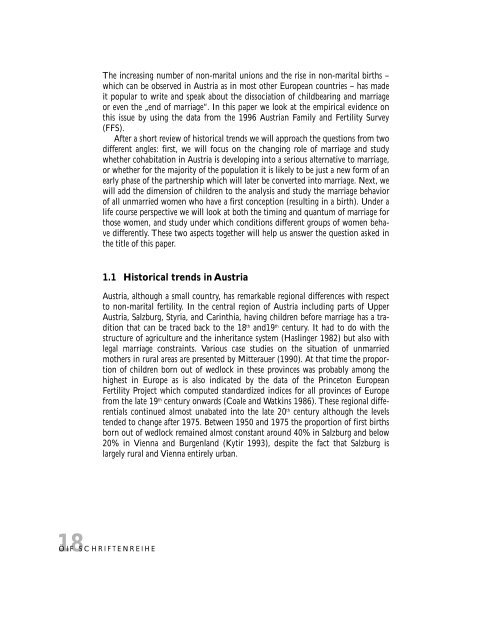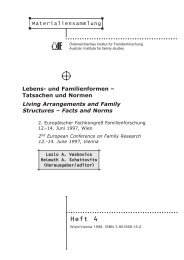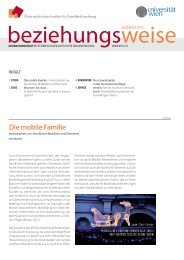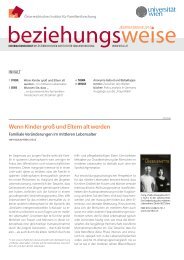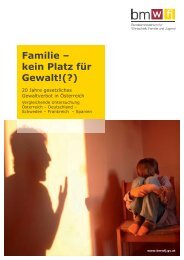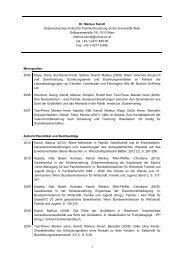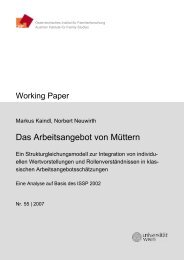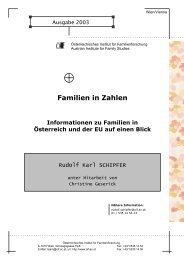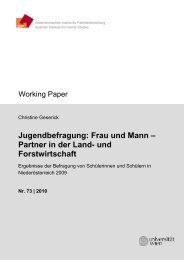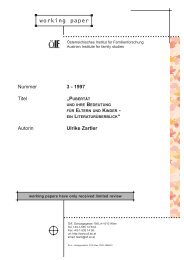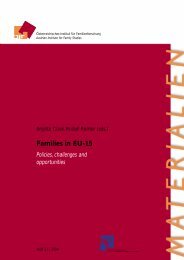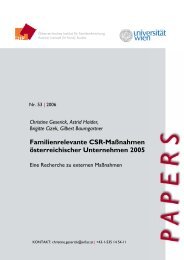Kompendium der Familienforschung in Ãsterreich, Schriftenreihe Nr. 7
Kompendium der Familienforschung in Ãsterreich, Schriftenreihe Nr. 7
Kompendium der Familienforschung in Ãsterreich, Schriftenreihe Nr. 7
Sie wollen auch ein ePaper? Erhöhen Sie die Reichweite Ihrer Titel.
YUMPU macht aus Druck-PDFs automatisch weboptimierte ePaper, die Google liebt.
The <strong>in</strong>creas<strong>in</strong>g number of non-marital unions and the rise <strong>in</strong> non-marital births –<br />
which can be observed <strong>in</strong> Austria as <strong>in</strong> most other European countries – has made<br />
it popular to write and speak about the dissociation of childbear<strong>in</strong>g and marriage<br />
or even the „end of marriage“. In this paper we look at the empirical evidence on<br />
this issue by us<strong>in</strong>g the data from the 1996 Austrian Family and Fertility Survey<br />
(FFS).<br />
After a short review of historical trends we will approach the questions from two<br />
different angles: first, we will focus on the chang<strong>in</strong>g role of marriage and study<br />
whether cohabitation <strong>in</strong> Austria is develop<strong>in</strong>g <strong>in</strong>to a serious alternative to marriage,<br />
or whether for the majority of the population it is likely to be just a new form of an<br />
early phase of the partnership which will later be converted <strong>in</strong>to marriage. Next, we<br />
will add the dimension of children to the analysis and study the marriage behavior<br />
of all unmarried women who have a first conception (result<strong>in</strong>g <strong>in</strong> a birth). Un<strong>der</strong> a<br />
life course perspective we will look at both the tim<strong>in</strong>g and quantum of marriage for<br />
those women, and study un<strong>der</strong> which conditions different groups of women behave<br />
differently. These two aspects together will help us answer the question asked <strong>in</strong><br />
the title of this paper.<br />
1.1 Historical trends <strong>in</strong> Austria<br />
Austria, although a small country, has remarkable regional differences with respect<br />
to non-marital fertility. In the central region of Austria <strong>in</strong>clud<strong>in</strong>g parts of Upper<br />
Austria, Salzburg, Styria, and Car<strong>in</strong>thia, hav<strong>in</strong>g children before marriage has a tradition<br />
that can be traced back to the 18 th and19 th century. It had to do with the<br />
structure of agriculture and the <strong>in</strong>heritance system (Hasl<strong>in</strong>ger 1982) but also with<br />
legal marriage constra<strong>in</strong>ts. Various case studies on the situation of unmarried<br />
mothers <strong>in</strong> rural areas are presented by Mitterauer (1990). At that time the proportion<br />
of children born out of wedlock <strong>in</strong> these prov<strong>in</strong>ces was probably among the<br />
highest <strong>in</strong> Europe as is also <strong>in</strong>dicated by the data of the Pr<strong>in</strong>ceton European<br />
Fertility Project which computed standardized <strong>in</strong>dices for all prov<strong>in</strong>ces of Europe<br />
from the late 19 th century onwards (Coale and Watk<strong>in</strong>s 1986). These regional differentials<br />
cont<strong>in</strong>ued almost unabated <strong>in</strong>to the late 20 th century although the levels<br />
tended to change after 1975. Between 1950 and 1975 the proportion of first births<br />
born out of wedlock rema<strong>in</strong>ed almost constant around 40% <strong>in</strong> Salzburg and below<br />
20% <strong>in</strong> Vienna and Burgenland (Kytir 1993), despite the fact that Salzburg is<br />
largely rural and Vienna entirely urban.<br />
18<br />
ÖIF SCHRIFTENREIHE


